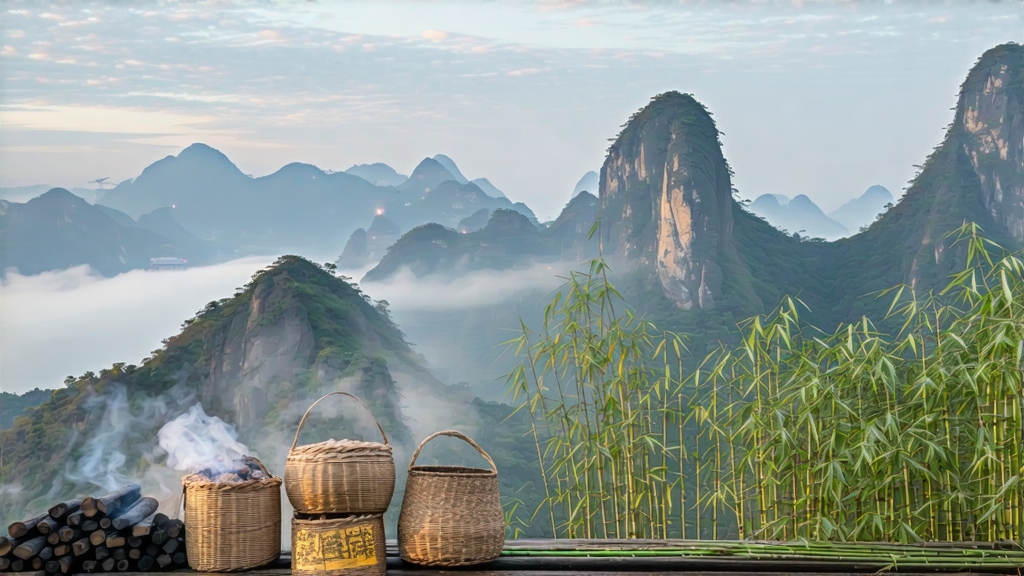
Tucked high in the mist-veiled Dabie Mountains of western Anhui Province, Huoshan Huangya has quietly captivated Chinese emperors, Tang-dynasty poets, and modern tea connoisseurs for more than fourteen centuries. Internationally it remains the least-known member of China’s six major tea families, yet within the arcane world of yellow teas it is regarded as the benchmark—an elixir whose gentle “micro-fermentation” turns spring buds from jade-green to pale champagne, coaxing out aromas of fresh chestnut, orchid, and steamed maize that linger like mountain mist in the throat. This article invites the global tea lover to discover why Huoshan Huangya was once reserved for the Son of Heaven, how its craft survives in only a handful of stone-walled villages, and how you can brew a cup that tastes like liquid sunrise.
-
Historical echoes
The first written record appears in the Shennong Bencaojing (Divine Farmer’s Materia Medica) of the Han era, but credible tribute-tea documentation begins in Tang dynasty tax registers (736 CE) listing “Huozhou Huangya” as an levy payable only in the finest buds. By Song times the tea had become currency for warhorses on the northern frontier; caravans carried compressed cakes of Huangya across the Silk Road, introducing the steppe tribes to the mellow sweetness that contrasted sharply with the astringent brick teas they knew. Ming emperors ennobled it further, stipulating that picking could not begin until the “third frost had lifted,” ensuring only the most tender shoots were plucked. When the Qing court moved to Beijing in 1644, Huoshan Huangya travelled in sealed bamboo tubes lined with silkworm paper, arriving at the Forbidden Palace still fragrant with mountain snow. Republican-era turmoil and Japanese occupation nearly extinguished the craft; by 1949 only three ageing masters remembered the full sequence of “menhuang” (sealed yellowing). A state-sponsored restoration project in 1972 located heirloom tea gardens above 600 m on Golden Rooster Ridge, grafted ancient trees, and re-established the slow charcoal-withering technique that defines the tea today. -
Terroir and gardens
Huoshan County lies on the northern edge of China’s subtropical belt, where cool air rolling down the Dabie range meets warm, humid currents from the Yangtze valley. The result is a 30 °C diurnal swing in April, locking floral volatiles inside the tiny buds. Soils are Phyllite-derived, rich in selenium and zinc, with a friable structure that forces roots to struggle, concentrating amino acids. The best plots—Jinjiwo (Golden Chicken Nest), Wulijing (Five-mile Ridge), and Baiyun’an (White Cloud Nunnery)—sit between 600 and 800 m, above the summer fog line but below the frost zone. Here, the Camellia sinensis var. sinensis ‘Huozao 1’ cultivar dominates: a slow-budding landrace with downy tips, low tannin, and an unusually high ratio of theanine to catechin, the biochemical key to Huangya’s syrupy mouthfeel. -
Harvest calendar
Plucking begins on the solar term Qingming (around 4 April) and ends before Grain Rain (20 April). Only the “flag-and-bud” set—one unopened apical bud flanked by a half-open leaf shaped like a miniature pennant—is taken. A skilled picker gathers barely 300 g in a dawn shift, the quantity needed for 50 g of finished tea after the successive moisture losses of menhuang and firing. Leaves must reach the village workshop within two hours; any delay oxidises the edges, ruining the signature yellow hue. -
Craft: the secret of menhuang
Yellow tea’s identity rests on a unique “smothering” or “sealed yellowing” step inserted between killing-green and rolling. In Huoshan this is performed in three micro-stages:
a. Initial kill-green: 220 °C on a shallow, cast-iron wok for 90 seconds, just enough to denature polyphenol oxidase while preserving a 12 % moisture core.
b. Hot-wrap menhuang: the semi-dry leaves are immediately piled 5 cm deep inside a linen sleeve, then slid into a bamboo cylinder lined with fresh chestnut leaves. The chestnut layer don